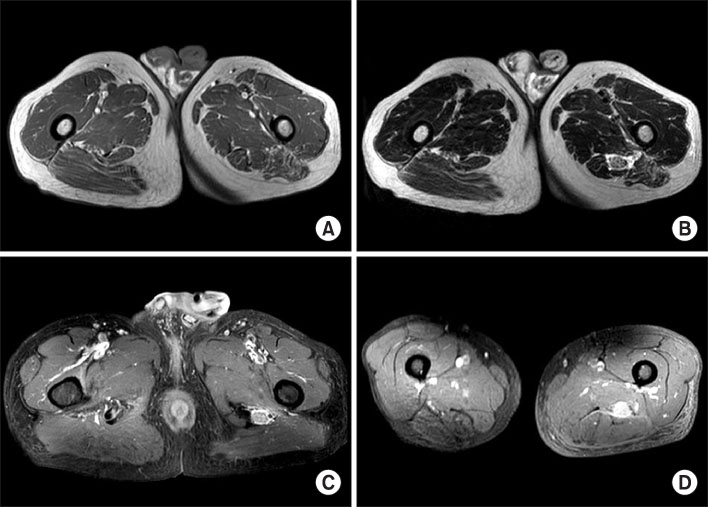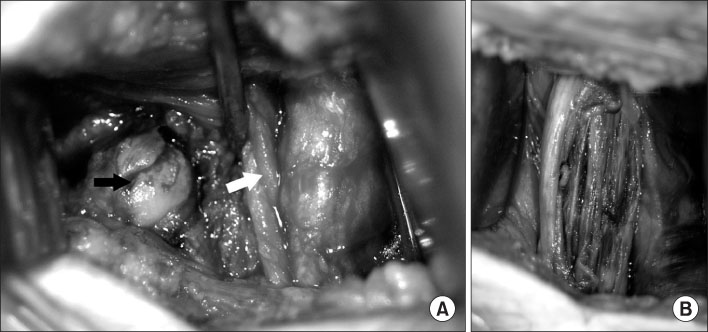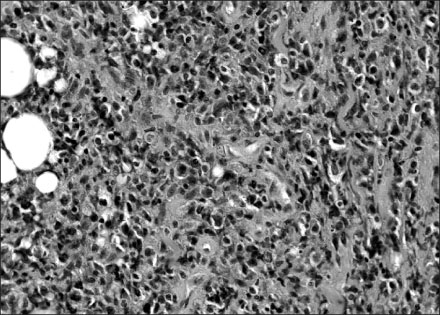J Korean Orthop Assoc.
2007 Oct;42(5):679-683. 10.4055/jkoa.2007.42.5.679.
Neurolymphomatosis Involving Sciatic Nerve: A Case Report
- Affiliations
-
- 1Department of Orthopaedic Surgery, Medical Center of Chung-Ang University, Seoul, Korea. sunu@cau.ac.kr
- KMID: 2186477
- DOI: http://doi.org/10.4055/jkoa.2007.42.5.679
Abstract
- The term "Neurolymphomatosis" includes the infiltration of the peripheral nervous system by lymphoma and nontumor lymphocytes. A neurolymphomatosis has not been classified as a distinct entity. Hence, its characteristic symptoms are often missed, and oncologists or neurological consultants fail to obtain an accurate diagnoses. We encountered a case of non-Hodgkins lymphoma involving the sciatic nerve, which has never been reported in the orthopedic literature in Korea. We report a case of neurolymphomatosis with a brief review of the literature.
Keyword
MeSH Terms
Figure
Reference
-
1. Baehring JM, Damek D, Martin EC, Betensky RA, Hochberg FH. Neurolymphomatosis. Neuro Oncol. 2003. 5:104–115.
Article2. Byun WM, Park WK, Park BH, Ahn SH, Hwang MS, Chang JC. Guillain-Barré syndrome: MR imaging findings of the spine in eight patients. Radiology. 1998. 208:137–141.
Article3. Currie S, Henson RA. Neurological syndromes in the reticuloses. Brain. 1971. 94:307–320.
Article4. Harris NL, Jaffe ES, Diebold J, Flandrin G, Muller-Hermelink HK, Vardiman J. Lymphoma classification--from controversy to consensus: the R.E.A.L. and WHO Classification of lymphoid neoplasms. Ann Oncol. 2000. 11:Suppl 1. 3–10.5. Hoerni-Simon G, Suchaud JP, Eghbali H, Coindre JM, Hoerni B. Secondary involvement of the central nervous system in malignant non-Hodgkin's lymphoma. A study of 30 cases in a series of 498 patients. Oncology. 1987. 44:98–101.6. Kajiya Y, Nakajo M, Kajiya Y, Miyaji N. Oculomotor nerve invasion by lymphoma demonstrated by MRI. J Comput Assist Tomogr. 1995. 19:502–504.
Article7. Manon-Espaillat R, Lanska DJ, Ruff RL, Masaryk T. Visualization of isolated trigeminal nerve invasion by lymphoma using gadolinium-enhanced magnetic resonance imaging. Neuroradiology. 1990. 32:531–532.
Article8. Recht LD. Neurologic complications of systemic lymphoma. Neurol Clin. 1991. 9:1001–1015.
Article9. Richmond J, Sherman RS, Diamond HD, Craver LF. Renal lesions associated with malignant lymphomas. Am J Med. 1962. 32:184–207.
Article10. Young RC, Howser DM, Anderson T, Fisher RI, Jaffe E, DeVita VT. Central nervous system complications of non-Hodgkin's lymphoma. The potential role for prophylactic therapy. Am J Med. 1979. 66:435–443.
- Full Text Links
- Actions
-
Cited
- CITED
-
- Close
- Share
- Similar articles
-
- Lumbosacral plexopathy due to neurolymphomatosis superimposed on traumatic nerve injury
- Sciatic nerve neurolymphomatosis as the initial presentation of primary diffuse large B-cell lymphoma: a rare cause of leg weakness
- A Case of Neurolymphomatosis Involving Cranial Nerve Diagnosed by PET-CT Imaging
- Combined Femoral and Sciatic Nerve Palsy Associated with Acetabular Fracture and Dislocation: A Case Report
- Neurolymphomatosis Involving Antebrachial Cutaneous Nerve





